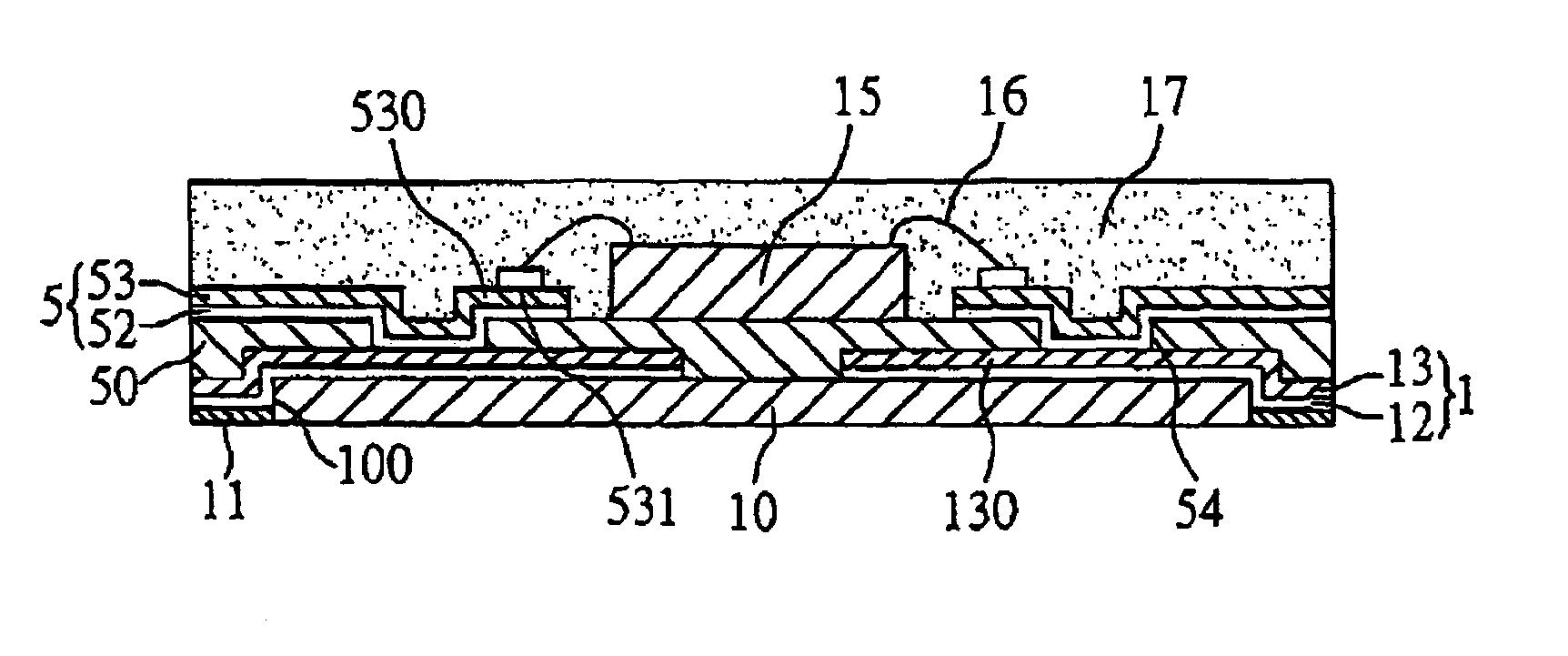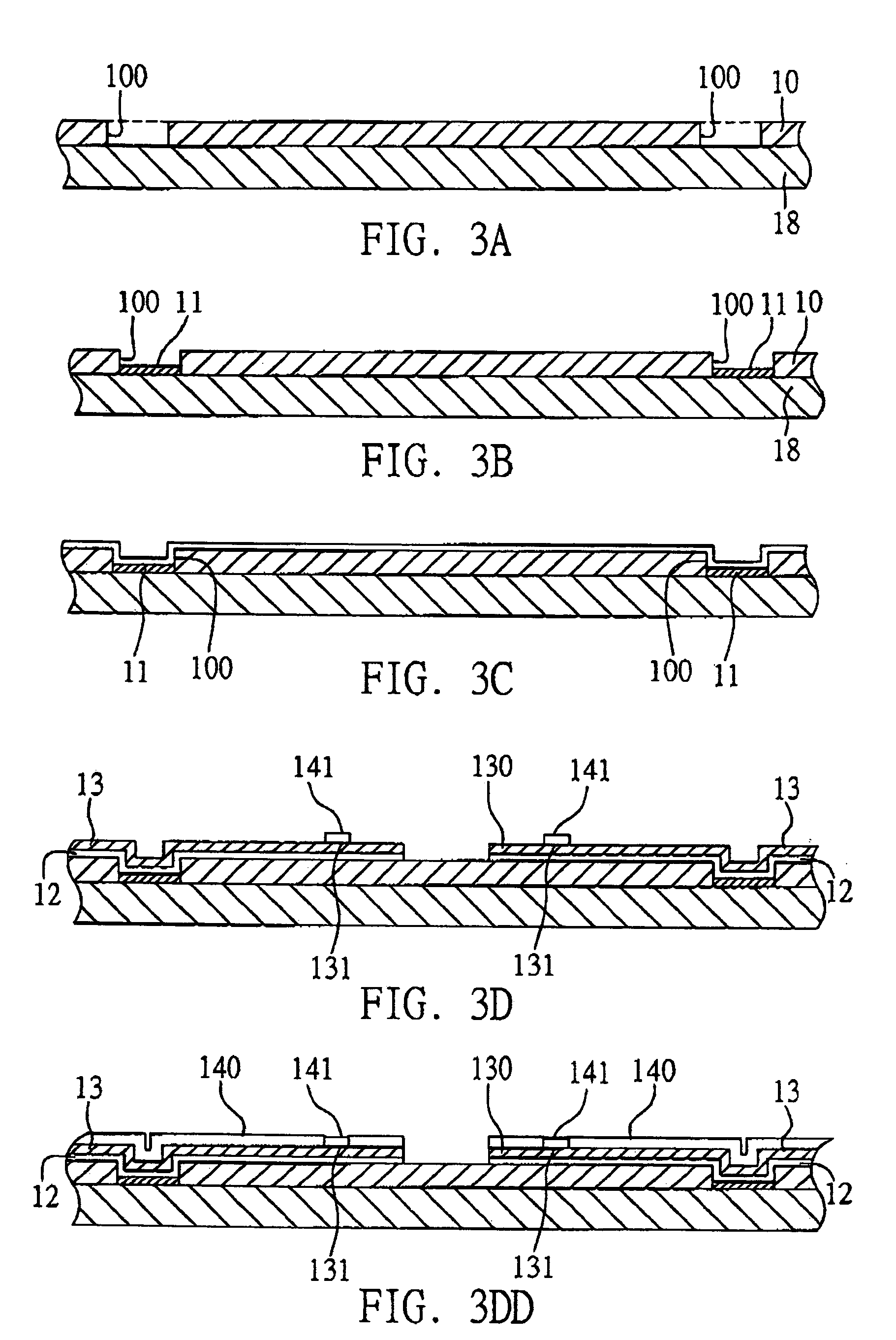Semiconductor package free of substrate and fabrication method thereof
a technology of semiconductors and substrates, applied in the manufacture of printed circuits, basic electric elements, solid-state devices, etc., can solve the problems of easy wire sweep or shift, short circuit, and difficult implementation of wire bonding process, so as to reduce the electrical connection path, shorten the bonding wire used, and eliminate the difficulty in performing the wire bonding process
- Summary
- Abstract
- Description
- Claims
- Application Information
AI Technical Summary
Benefits of technology
Problems solved by technology
Method used
Image
Examples
first preferred embodiment
[0032]The present invention provides a semiconductor package free of using a substrate; as shown in FIGS. 1 and 2, this semiconductor package includes a dielectric material layer 10 formed with a plurality of openings 100 penetrating through the dielectric material layer 10; a solder material 11 applied in each of the openings 100; a first copper layer 12 formed over the dielectric material layer 10 and solder materials 11 in the openings 100; a second copper layer 13 formed over the first copper layer 12, allowing the first and second copper layers 12, 13 to be patterned to form a plurality of conductive traces 130 each having a terminal 131, wherein the first copper layer 12 is smaller in thickness than the second copper layer 13; a metal layer 141 applied on each of the terminals 131; at least one chip 15 mounted on a predetermined portion of the conductive traces 130; a plurality of bonding wires 16 for electrically connecting the chip 15 to the metal layers 141 of the terminals...
second preferred embodiment
[0045]FIG. 4 illustrates a semiconductor package according to a second preferred embodiment of the invention. As shown in the drawing, this semiconductor package differs from that of the above first embodiment in that the chip 15 is mounted in a flip-chip manner on the conductive traces 130. In particular, during a die bonding process, the active surface 150 of the chip 15 is directed toward the conductive traces 130 and electrically connected via solder bumps 16′ to the terminals 131 of the conductive traces 130 where the terminals 131 serve as bond pads used to be bonded with the solder bumps 16′. Alternatively, an insulating layer 140 can be applied over the conductive traces 130 with the terminals 131 being exposed and connected to the solder bumps 16′.
[0046]Compared to the use of bonding wires for electrically connecting the chip and conductive traces, the flip-chip technology can further reduce an electrical connection distance from the chip 15 to conductive traces 130 via sol...
third preferred embodiment
[0048]FIG. 5 illustrates a semiconductor package according to a third preferred embodiment of the invention. This semiconductor package differs from that of the above first embodiment in that a plurality of solder balls 19 are implanted on the exposed solder materials 11 to form a ball grid array. These solder balls 19 serve as I / O connections of the semiconductor package to be electrically connected with an external device (not shown).
PUM
| Property | Measurement | Unit |
|---|---|---|
| thick | aaaaa | aaaaa |
| thickness | aaaaa | aaaaa |
| thick | aaaaa | aaaaa |
Abstract
Description
Claims
Application Information
 Login to View More
Login to View More - R&D
- Intellectual Property
- Life Sciences
- Materials
- Tech Scout
- Unparalleled Data Quality
- Higher Quality Content
- 60% Fewer Hallucinations
Browse by: Latest US Patents, China's latest patents, Technical Efficacy Thesaurus, Application Domain, Technology Topic, Popular Technical Reports.
© 2025 PatSnap. All rights reserved.Legal|Privacy policy|Modern Slavery Act Transparency Statement|Sitemap|About US| Contact US: help@patsnap.com



